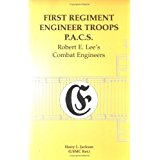1st Regiment, Confederate Engineer Troops
The 1st Engineers Regiment was organized at Richmond, Virginia, during the fall of 1863 with men from North Carolina and Virginia. In December about 250 of these men were repairing roads in the Richmond area. Later the unit served as prison guards, then repaired railroads and bridges. During the winter of 1864 - 1865 it built Bevill's Bridge over the Appomattox River about twenty-five miles above Petersburg and sent a pontoon bridge to the Richmond and Danville Railroad Crossing of the Staunton River. In preparation for the spring campaign, it readied another pontoon bridge for use at the site of the roads from Richmond and Petersburg to the several crossings ot the Appomattox. The unit last 2 men killed and 28 wounded during the war, and when the Army of Northern Virginia surrendered 233 were present. Its commanders were Colonel Thomas M. R. Talcott, Lieutenant Colonel William W. Blackford, and Major Peyton Randolph. 2nd Engineers Regiment was assembled during the summer of 1863 with men from almost every Confederate state east of the Mississippi River. This regiment did not serve as one command. Companies A and E were stationed at Fort Fisher, North Carolina; Companies B, F, and I were at Forts Gaines and Morgan, Alabama; Company D (The Unit that we Portray) was at Fort McAllister, Georgia; and Companies C, G, H, and K were with the forces in Virginia. These four companies, for the most part, served under Colonel T. M. R. Talcott of the 1st Engineers Regiment. The companies surrendered with the army or department in which they served, and those with the Army of Nothern Virginia totalled 97 officers and men. Major D. Wintter was in command.
There is a discussion of this unit On Line at the American Civil War website.
http://www.angelfire.com/rebellion2/engineers/history.html
It should therefore come as no surprise to read in this account of the South's one fully formed combat engineer unit, that it came into being late on in the war, in March 1863, when the Southern congress authorized full engineer units. A company was to be raised in each infantry division, in violation of the principal that "scarce resources are best held centrally". Throughout the Gettysburg Campaign, engineers were deployed it penny packets. The author relates that Lee's pontoon bridge at Falling Waters was cared for by a detachment of just 14 engineers, who were captured whey the Union forces destroyed the bridge. At that stage the dispersed engineer companies were brought together to construct pontoons from scratch. After 36 hours the first ones were ready and a 23-pontoon bridge was constructed in another 48 hours, enabling the Arm: of Northern Virginia to withdraw.
Clearly mindful of the enormous losses, Lee ordered the engineer companies back to their divisions. After some horse-trading with the Secretary for War it was agreed that the companies should be formed into a regiment for purposes of pooled expertise and esprit de corps. Thus, throughout the late summer of 1863 the Engineer Regiment was formed from a nucleus of people drawn from existing units, and brought up to around 60 percent of its authorized strength with new con scripts. The regiment started to train centrally, and by November 1863 a dedicated pontoon company had been created. But it was not until Christmas that the unit approached its desired strength of 1,000, and it remained in camp, training, until April 1864.
The unit was not involved in the Wilderness Campaign, but throughout June it was split up to build and maintain bridges in the vicinity of the Chickahominy River, a notorious obstacle east of Richmond. Throughout the summer the engineers came into their own and proved their worth, their time split between building bridges, forts, and occasionally being used as infantry to plug gaps in the lines.
Some 70 pages, almost half of the book, describe the static defence of Petersburg starting in late 1864. Again the regiment proved its worth, ready to deploy quickly to wherever the priority was. The skilled unit was able to stave off the Union's more original attempts to break into the Petersburg trench defences over a nine-month period. The book is authoritative in its details, for example, of the production line needed to manufacture the basics for trench warfare: fascines, gabions, sap rollers, cheval de fries and sap fagots. But inclusion of documents such as the pay scales for all ranks breaks the flow of the narrative and should have been relegated to annexes. This is a slightly uneven read of a most interesting subject. The book is clearly a labour of love for its author, a retired US Marine, and his enthusiasm for the subject shines through. While the book has some technical imperfections, nonetheless it is an important subject, well worth appearing in print.
(Reviewer John Drewienkiewicz was formerly Engineer-in-Chief of the British Army)
Dyer, Frederick H. - A Compendium of the War of the Rebellion

